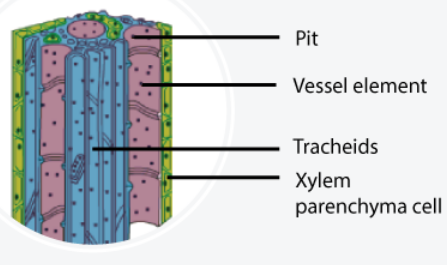
Name the largest plant cell.
Answer
397.2k+ views
Hint: Plant cells are eukaryotes, which are made up of specialised cellular organelles that differ from animal cells in numerous key ways. Plant cells typically have a strong cell wall that keeps them upright and protects them from losing their form. To keep the plant active, the plasma membrane, cytoplasm, and all other cell organelles work together. The water in the plant cell is held in vacuoles, a fluid-filled membrane-bound organelle situated within the cytoplasm. Plant and animal cells are both eukaryotic and have a few cell organelles in common, although plant cells have different functions than animal cells.
Complete answer:
The xylem cells are the largest plant cells. The tissue in a plant that acts as the plant's blood vessels is called xylem. From the roots to the leaves, it delivers water and some nutrients. Dead cells with thick, lignified secondary cell walls make up the xylem. In vascular plants, xylem cells are the transport cells. They aid in the transportation of water and minerals from the roots to the leaves and other plant components.
Vessels, tracheids, woody fibres, and parenchyma cells make up the parenchyma. Mechanical strength is also provided by ylem. The main elements for conducting water are tracheids and vessels. The xylem fibres offer mechanical support, whereas the xylem parenchyma stores food and tannins as well as conducting water radially.
Primary xylem and secondary xylem are the two types of xylems.
Protoxylem is the first formed primary xylem, and metaxylem is the second formed primary xylem. There are two forms of primary xylem organisation: Endarch is found in the stem, while protoxylem is found near the pith and metaxylem is found towards the periphery. Exarch is found in the roots, metaxylem is found in the middle, and protoxylem is found on the periphery. Secondary xylem: these are created as a result of the vascular cambium's action and are responsible for the plant's increased girth. Secondary xylem develops from cells that cut off towards the pith. An annual ring is generated by the two forms of secondary xylem that form in the spring and autumn.

Additional information:
Plant cells' chloroplasts are where photosynthesis takes place. Chloroplast is made up of chlorophyll, a green pigment. The light processes take place in the chloroplast's thylakoids, which contain the chlorophyll pigment.
Note:
Plant cells are eukaryotic cells with a genuine nucleus and organelles that execute distinct activities. Chloroplast, cell wall, plastids, and a huge central vacuole are organelles found uniquely in plant cells. The green pigment chlorophyll is found in chloroplasts and is responsible for photosynthesis. Plant cells are classified as collenchyma, sclerenchyma, parenchyma, xylem, and phloem. A plant's cell wall is made up of cellulose. Cellulose is a polymer made up of multiple glucose molecules that is long and linear.
Complete answer:
The xylem cells are the largest plant cells. The tissue in a plant that acts as the plant's blood vessels is called xylem. From the roots to the leaves, it delivers water and some nutrients. Dead cells with thick, lignified secondary cell walls make up the xylem. In vascular plants, xylem cells are the transport cells. They aid in the transportation of water and minerals from the roots to the leaves and other plant components.
Vessels, tracheids, woody fibres, and parenchyma cells make up the parenchyma. Mechanical strength is also provided by ylem. The main elements for conducting water are tracheids and vessels. The xylem fibres offer mechanical support, whereas the xylem parenchyma stores food and tannins as well as conducting water radially.
Primary xylem and secondary xylem are the two types of xylems.
Protoxylem is the first formed primary xylem, and metaxylem is the second formed primary xylem. There are two forms of primary xylem organisation: Endarch is found in the stem, while protoxylem is found near the pith and metaxylem is found towards the periphery. Exarch is found in the roots, metaxylem is found in the middle, and protoxylem is found on the periphery. Secondary xylem: these are created as a result of the vascular cambium's action and are responsible for the plant's increased girth. Secondary xylem develops from cells that cut off towards the pith. An annual ring is generated by the two forms of secondary xylem that form in the spring and autumn.

Additional information:
Plant cells' chloroplasts are where photosynthesis takes place. Chloroplast is made up of chlorophyll, a green pigment. The light processes take place in the chloroplast's thylakoids, which contain the chlorophyll pigment.
Note:
Plant cells are eukaryotic cells with a genuine nucleus and organelles that execute distinct activities. Chloroplast, cell wall, plastids, and a huge central vacuole are organelles found uniquely in plant cells. The green pigment chlorophyll is found in chloroplasts and is responsible for photosynthesis. Plant cells are classified as collenchyma, sclerenchyma, parenchyma, xylem, and phloem. A plant's cell wall is made up of cellulose. Cellulose is a polymer made up of multiple glucose molecules that is long and linear.
Recently Updated Pages
Master Class 11 Accountancy: Engaging Questions & Answers for Success

Glucose when reduced with HI and red Phosphorus gives class 11 chemistry CBSE

The highest possible oxidation states of Uranium and class 11 chemistry CBSE

Find the value of x if the mode of the following data class 11 maths CBSE

Which of the following can be used in the Friedel Crafts class 11 chemistry CBSE

A sphere of mass 40 kg is attracted by a second sphere class 11 physics CBSE

Trending doubts
10 examples of friction in our daily life

Difference Between Prokaryotic Cells and Eukaryotic Cells

State and prove Bernoullis theorem class 11 physics CBSE

What organs are located on the left side of your body class 11 biology CBSE

Define least count of vernier callipers How do you class 11 physics CBSE

The combining capacity of an element is known as i class 11 chemistry CBSE




